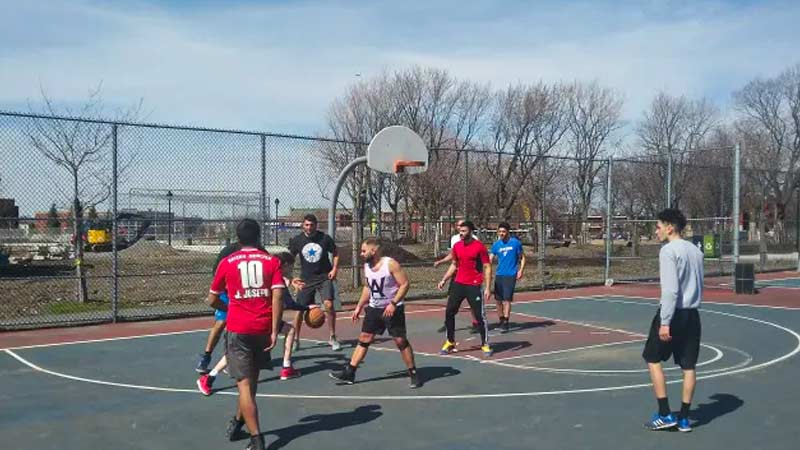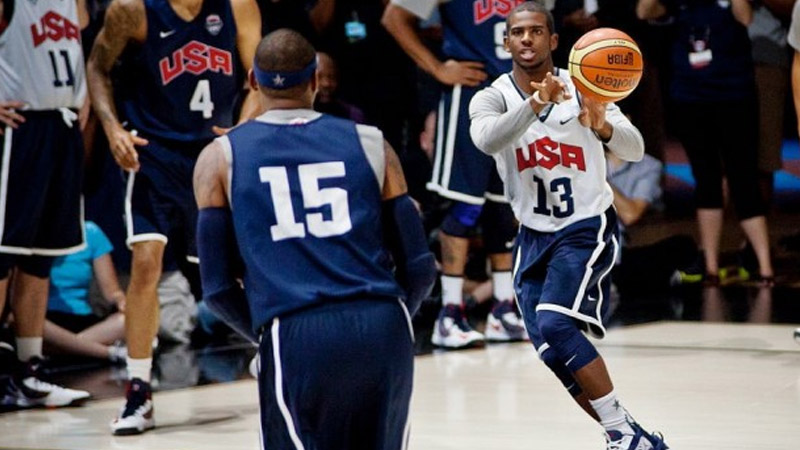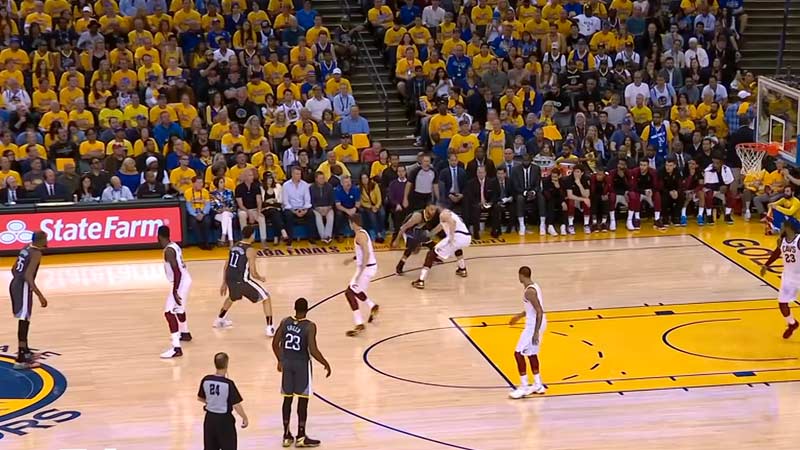Basketball is a sport that thrives on strategic plays and teamwork. One such play that embodies the essence of collaboration and precise execution is the give-and-go.
The give-and-go is a fundamental offensive strategy that involves a quick exchange of passes between two players to create scoring opportunities. It requires impeccable timing, communication, and trust between teammates.
In this blog post, we will explore the concept of the give-and-go in basketball, its benefits, execution techniques, and examples from professional basketball.
Whether you’re a player, coach, or avid fan, understanding the intricacies of the give-and-go will deepen your appreciation for the game and unlock new possibilities on the court.
What Is a Give-And-Go in Basketball?
The give-and-go is a fundamental offensive play in basketball that involves a quick exchange of passes between two teammates to create scoring opportunities.
It relies on teamwork, communication, and precise timing to catch the defense off-guard and create an advantage for the offensive team.
In a typical give-and-go, one player (the passer) passes the ball to a teammate (the receiver) and immediately cuts toward the basket or moves into open space. The receiver then passes the ball back to the original passer, who is now in a better position to score or make a play.
The give-and-go is effective because it confuses defenders who must react quickly to the exchange of passes. The quick movement and precise timing make it difficult for defenders to stay with both players involved in the play.
This play is often used to break down defenses, create open lanes for drives to the basket, or generate scoring opportunities through layups, dunks, or jump shots.
What Is the Strategy of Give-And-Go in Basketball?

Source:bild-lida.ca
The give-and-go strategy in basketball is a dynamic offensive tactic that involves coordinated movement and passing between two players to create scoring opportunities.
The primary objective of the give-and-go is to break down the defense, confuse defenders, and generate open lanes for the offensive player to score or make a play. Here are some key strategies and considerations for effectively using the give-and-go:
Communication and Timing
Effective communication and precise timing are crucial for a successful give-and-go play. Players must establish clear signals and cues to anticipate each other’s movements and execute the play with split-second timing.
Spacing and Positioning
Proper spacing on the court is essential to allow the passer to make an effective pass and the receiver to create separation from the defender. Players should position themselves strategically to maximize passing angles and minimize defensive pressure.
Read the Defense
Before initiating the give-and-go, both players must assess the defense. This involves identifying defensive rotations, gaps, and potential openings that can be exploited with quick passes and cuts. Reading the defense allows the offensive players to make informed decisions and react accordingly.
Cutting and Movement
The receiver’s movement after the initial pass is critical. They should cut decisively towards the basket or into open space, aiming to create separation from their defender. Sharp cuts, changes of direction, and using screens effectively can help the receiver get open for the return pass.
Passing Techniques
Precise and accurate passing is vital for the give-and-go. Both the initial pass and the return pass need to be executed with speed, accuracy, and appropriate timing. Different types of passes, such as bounce passes, chest passes, or lob passes, may be used depending on the situation and defensive positioning.
Trust and Unselfishness
The give-and-go requires trust and a selfless mindset among teammates. Both players involved in the play must trust that their teammates will make the right decisions and deliver accurate passes.
Additionally, players should prioritize the success of the team over personal glory, being willing to pass and cut without hesitation.
Practice and Repetition
Mastering the give-and-go requires practice. Players should work on their timing, cutting angles, passing accuracy, and overall execution of the play through drills and simulated game situations.
Repetition helps build muscle memory and enhances the chemistry between teammates.
The give-and-go is an effective strategy that promotes teamwork, coordination, and quick decision-making on the basketball court. By incorporating these strategies into their game, teams can unlock the potential of the give-and-go to create scoring opportunities and keep the defense guessing.
Benefits of Give and Go in Basketball

Source: stack.com
The give-and-go is a highly effective play in basketball that offers several benefits for the offensive team. Here are some key advantages of incorporating the give-and-go into your offensive strategy:
Breaking Down the Defense
The give-and-go play can create confusion and disrupt the defensive structure.
The quick exchange of passes and movement forces defenders to make split-second decisions, opening up opportunities for offensive players to exploit defensive gaps or mismatches.
Creating Scoring Opportunities
The give-and-go is designed to generate scoring chances. By executing the play successfully, offensive players can create open lanes to the basket, allowing for layups, dunks, or close-range shots.
The play can also lead to kick-out passes for open perimeter jump shots if the defense collapses to stop the initial drive.
Exploiting Defensive Rotations
When the give-and-go is executed with precision, it forces defenders to rotate and adjust quickly. This can lead to defensive breakdowns, leaving players open for easy scoring opportunities or creating advantages elsewhere on the court.
The play forces defenders to make difficult choices and can lead to defensive overcommitment or miscommunication.
Fostering Teamwork and Chemistry
The give-and-go requires effective communication and trust between teammates.
Implementing this play encourages players to work together, communicate, and develop a deeper understanding of each other’s tendencies and movements on the court. It promotes a selfless mindset and enhances overall team chemistry.
Expanding Offensive Options
The give-and-go adds versatility to an offensive repertoire. It can be utilized in various situations, including half-court sets, fast breaks, and pick-and-roll scenarios.
By incorporating the give-and-go into their game plan, teams become more unpredictable and challenging to defend, as they have an additional tool to keep the defense guessing.
Drawing Defensive Attention
The give-and-go play often attracts defensive attention. As defenders focus on the players involved in the exchange, it creates opportunities for other teammates to find open spaces or cut to the basket, leading to secondary scoring chances or passing lanes.
Enhancing Offensive Flow
The give-and-go promotes fluidity and ball movement within the offense. It encourages players to make quick decisions, move off the ball, and keep the defense on its heels.
The play can lead to a more rhythmic and efficient offensive flow, as players develop a better understanding of spacing and timing.
The give-and-go offers numerous benefits to the offensive team, including breaking down the defense, creating scoring opportunities, fostering teamwork, expanding offensive options, drawing defensive attention, and enhancing overall offensive flow.
Incorporating this play into a team’s strategy can significantly impact their success on the basketball court.
Drawbacks of Give and Go in Basketball
While the give-and-go is a valuable offensive strategy in basketball, it also has some potential drawbacks that players and teams should be aware of. These drawbacks include:
Defensive Anticipation
The give-and-go relies on quick passes and cuts, but experienced defenders can anticipate the play and disrupt the passing lanes. Defenders who read the cues or recognize the pattern of the give-and-go can intercept the pass or disrupt the offensive flow.
Timing Challenges
Executing the give-and-go requires precise timing between the passer and the receiver. If the timing is off, the play may result in a turnover or a missed opportunity. It takes practice and chemistry between teammates to perfect the timing, and even then, it may not always be executed flawlessly.
Defensive Adjustments
Effective defensive teams may adjust their strategies to counter the give-and-go. They may switch defenders, apply more pressure on the passer, or deny passing lanes, making it harder to execute the play successfully. This requires the offensive team to have alternative strategies and plays in their repertoire.
Limited Space and Congestion
In crowded or tightly defended areas, executing the give-and-go becomes challenging. When the court is congested with defenders, passing lanes may be limited, and the offensive player’s cuts may be impeded. This can lead to turnovers or forced shots, reducing the effectiveness of the play.
Overreliance on Two Players
The give-and-go is primarily a two-player play involving the passer and the receiver. Depending too heavily on this play can lead to predictability and make the offense easier to defend. A well-prepared defense can focus on stopping these two players, forcing other teammates to step up and contribute.
Physicality and Fouls
The give-and-go involves close proximity between offensive and defensive players, which can lead to physical contact and potential fouls. Aggressive defenders may try to impede the receiver’s cuts or disrupt the passing lanes, resulting in offensive fouls or turnovers.
Skill and Experience Requirements
Executing the give-and-go effectively requires a certain level of skill, coordination, and experience from both the passer and the receiver. Players who are not proficient in passing, cutting, or reading the defense may struggle to execute the play successfully.
Despite these drawbacks, the give-and-go remains a valuable offensive tool in basketball. Being aware of these challenges allows teams to adapt their strategies, incorporate variations, and have alternative plays in their playbook to maintain offensive effectiveness.
FAQs
What is a give-and-go in basketball?
The give-and-go is an offensive strategy in basketball where one player passes the ball to a teammate and immediately cuts toward the basket or into open space. The passer then receives the ball back from their teammate and is in a better position to score or make a play.
What are the benefits of using the give-and-go?
The give-and-go is highly effective for several reasons. It confuses defenders, creates scoring opportunities, and breaks down the defense by exploiting quick exchanges and movements.
It also promotes teamwork, builds chemistry between teammates, and encourages unselfish play.
How important is timing in executing the give-and-go?
Timing is critical for a successful give-and-go. Players must coordinate their movements and pass precisely to catch the defense off-guard. Proper timing ensures that the receiver is open when the return pass arrives, creating a seamless and efficient play.
What are some key execution techniques for the give-and-go?
Successful execution of the give-and-go involves setting up the play with proper spacing, reading the defense, using effective cutting and movement, and employing accurate passing techniques.
Players must communicate non-verbally, anticipate each other’s movements, and make quick decisions based on the defensive situation.
Can you provide examples of the give-and-go in professional basketball?
Professional basketball teams often utilize the give-and-go as part of their offensive strategies. Examples include the Golden State Warriors motion offense, known for its fluid passing and cutting, and the San Antonio Spurs’ precision passing game.
Legendary duos like Magic Johnson and James Worthy, or John Stockton and Karl Malone, also showcased the mastery of the give-and-go with their impeccable timing and chemistry.
Wrapping Up
The give-and-go is a dynamic and essential play in basketball that exemplifies the beauty of teamwork and precision. It requires effective communication, timing, and execution to create scoring opportunities and disrupt the defense.
While it may have its challenges, understanding the fundamentals of the give-and-go empowers players and teams to elevate their game and foster a cohesive playing style.
By incorporating this strategy into their arsenal, athletes can experience the joy of collaborative play and unlock new dimensions of success on the basketball court.







